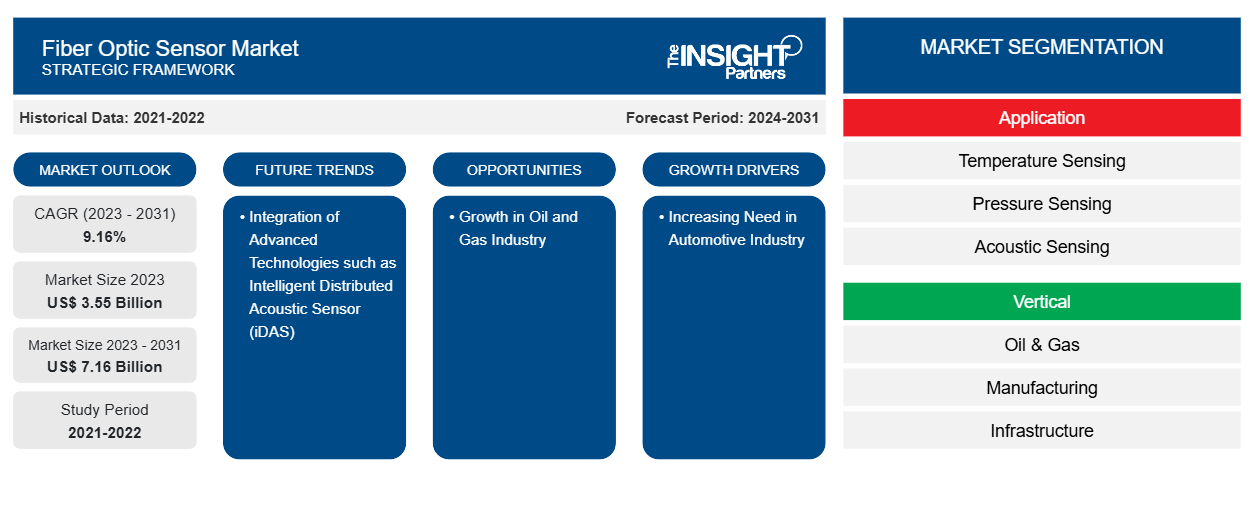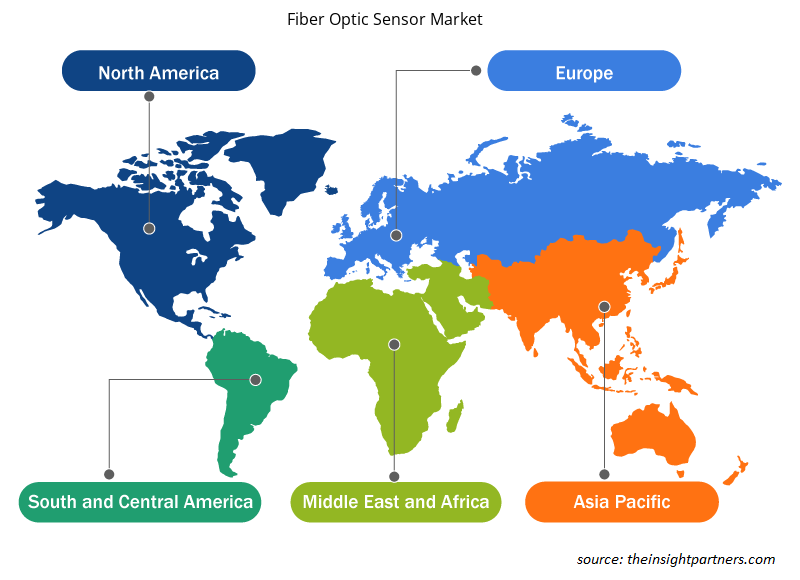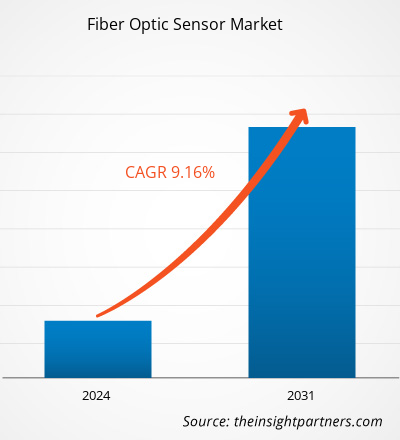광섬유 센서 시장 규모는 2024년 36억 1천만 달러에서 2031년 67억 6천만 달러로 성장할 것으로 예상됩니다. 2025년부터 2031년까지 연평균 성장률(CAGR)은 9.7%에 이를 것으로 예상됩니다. 소형화와 휴대성 향상은 향후 몇 년 동안 시장에 새로운 트렌드를 가져올 것으로 예상됩니다.
광섬유 센서 시장 분석
광섬유 센싱은 화학적 변화, 변형률, 온도, 전기장 및 자기장, 압력, 변위, 회전, 복사, 액체 수위, 유량, 광도, 진동 등을 측정하는 데 사용되는 기술입니다. 광섬유 센서는 광섬유를 사용하여 환경 변화를 감지하는 내장형 센서(내부 센서) 또는 원격 센서에서 처리 장비로 신호를 전달하는 외부 센서(외부 센서)를 사용하는 장치입니다. 이러한 소형 센서는 여러 가지 장점 때문에 원격 센싱에 널리 사용됩니다. 감지 지점에 전력이 필요하지 않으며, 하나의 광섬유로 여러 센서를 지원할 수 있습니다. 이러한 장점 덕분에 장거리 작업 모니터링에 비용 효율적이고 효율적입니다. 광섬유 센서는 내구성이 뛰어나고 극한의 온도에서도 작동할 수 있습니다. 전기를 전달하지 않기 때문에 전기 간섭이 심하거나 고전압 또는 가연성 물질이 있는 환경에서도 잘 작동합니다. 따라서 석유 및 가스, 건설, 항공우주, 의료 등의 산업에 이상적입니다.
광섬유 센서 시장 개요
석유 및 가스 부문의 응용 분야 급증과 다양한 산업 분야에서 구조 건전성 모니터링(SHM)에 대한 수요 급증은 광섬유 센서 시장을 견인하는 핵심 요인입니다. 이러한 센서는 건물, 파이프라인, 운송 시스템의 안전성과 효율성을 향상시키는 데 중요한 역할을 합니다. 석유 및 가스, 전력, 통신 등의 산업 또한 성능과 신뢰성 향상을 위해 이러한 감지 기술을 도입하고 있습니다. 더 많은 산업이 자동화 및 스마트 시스템으로 전환함에 따라, 글로벌 광섬유 센서 시장은 향후 몇 년간 꾸준히 성장할 것으로 예상됩니다. 스마트 시티의 발전과 재생에너지 부문의 성장은 가까운 미래에 시장에서 수익성 있는 기회를 창출할 것입니다.
이 보고서의 일부 또는 국가 수준 분석, Excel 데이터 팩을 포함하여 모든 보고서에 대한 사용자 정의를 무료로 받을 수 있으며, 신생 기업 및 대학을 위한 훌륭한 혜택과 할인도 이용할 수 있습니다.
광섬유 센서 시장: 전략적 통찰력

-
이 보고서에서 주요 시장 동향을 알아보세요.이 무료 샘플에는 시장 동향부터 추정치 및 예측까지 다양한 데이터 분석이 포함됩니다.
광섬유 센서 시장 동인 및 기회
구조 건강 모니터링에 대한 급증하는 수요
전 세계적으로 인프라 안전과 실시간 모니터링에 대한 관심이 높아지고 있으며, 이는 첨단 구조 건전성 모니터링 (SHM) 시스템에 대한 수요를 견인하고 있습니다. 현대 도시의 확장과 인프라의 노후화로 인해 교량, 터널, 댐, 건물과 같은 구조물의 손상이나 고장 징후를 조기에 감지해야 할 필요성이 끊임없이 커지고 있습니다. 저항성 스트레인 게이지와 같은 기존 시스템은 내구성, 장기 정확도, 적응성 측면에서 종종 부족합니다. 광섬유 센서는 컴팩트한 디자인, 내식성, 전자파 간섭 내성 등의 장점을 제공하여 기존 모니터링 시스템의 탁월한 대안으로 부상했습니다. 또한, 구조물에 직접 내장할 수 있다는 점도 인기를 더하고 있습니다. 이러한 특성 덕분에 광섬유 센서는 까다로운 환경에서도 장기적인 SHM(구조 건전성 모니터링)에 이상적입니다. 광섬유 센서는 인프라의 무결성과 안전을 유지하는 데 필수적인 변형률, 온도, 진동, 기울기와 같은 주요 물리적 매개변수를 정확하게 측정할 수 있습니다.
증가하는 수요에 대응하기 위해 광섬유 센서 시장 기업들은 기술 확장을 위한 투자를 확보하고 있습니다. 예를 들어, imec에서 분사하여 광섬유 센서용 판독 시스템 공급업체로 성장한 Sentea는 2021년 사업 확장을 위해 약 260만 달러(230만 유로)의 투자를 유치하는 데 성공했습니다. 이 투자는 2021년 10월에 발표되었습니다. Finindus, PMV, QBIC II, Fidimec 등의 투자자들의 지원을 받는 Sentea의 확장 계획은 토목 공학, 석유 및 가스, 재생 에너지, 의료 분야 등에서 대규모 광섬유 센싱을 가능하게 하는 광자 집적 기술 발전에 중점을 두고 있습니다. 이러한 투자는 SHM(Short-Heading Management) 분야에서 광섬유 센싱 기술 도입의 잠재력이 커지고 있음을 보여주며, 광섬유 센서 시장의 성장을 촉진하고 있습니다.
스마트 시티 개발
인도 정부는 2015년 6월 25일, 스마트 솔루션을 활용하여 현대적인 인프라, 깨끗하고 지속가능한 환경, 그리고 향상된 삶의 질을 갖춘 전국 100개 도시를 개발한다는 목표로 '100 스마트 시티 미션(100 Smart Cities Mission)'을 출범시켰습니다. 이 미션은 중앙 정부 지원 계획(Centrally Sponsored Scheme)에 따라 사회적, 경제적, 물리적, 제도적 측면의 총체적인 도시 개발을 촉진하며, 약 64억 달러(48조 루피)의 중앙 정부 예산과 주 정부 및 공공 민간 파트너십(PPP)을 포함한 기타 재원의 매칭을 지원합니다. 이 미션은 다른 도시들이 따라갈 수 있도록 지속가능하고 포용적인 도시 성장의 복제 가능한 모델을 구축하는 것을 목표로 합니다. 유럽 연합(EU)에서는 NetZeroCities가 Horizon Europe 프로그램의 일환으로 "2030년까지 기후 중립적이고 스마트한 100개 도시" 미션을 지원합니다.
스마트 시티가 확장됨에 따라 광섬유 센서와 같은 고급 모니터링 도구에 대한 필요성은 계속해서 증가할 것입니다. 이러한 센서는 실시간 데이터를 제공하고 혹독한 환경에서도 잘 작동하며, 장기적인 데이터 전송을 제공합니다. 이러한 센서는 교량, 도로, 터널, 건물, 수도관, 에너지 시스템 모니터링에 사용될 수 있습니다. 예를 들어, 교량의 균열, 파이프라인 누수, 전력망의 온도 변화를 감지하여 시 당국이 문제가 심각해지기 전에 조치를 취할 수 있도록 지원합니다. 이러한 센서는 스마트 교통 시스템, 스마트 그리드, 스마트 빌딩에도 사용되어 성능과 안전성을 향상시킵니다. 따라서 스마트 시티의 성장은 연결되고 효율적인 시스템을 구축하는 데 도움이 되는 광섬유 센서 시장에 수익성 있는 기회를 제공합니다.
광섬유 센서 시장 보고서 세분화 분석
광섬유 센서 시장 분석 에 기여한 주요 세그먼트는 감지 유형, 최종 사용자 및 응용 프로그램입니다.
- 감지 유형에 따라 광섬유 센서 시장은 온도 감지, 압력 감지, 음향 감지, 변형 감지 등으로 세분화됩니다. 온도 감지 부문은 2024년에 시장 점유율 1위를 차지했습니다.
- 최종 사용자 기준으로 광섬유 센서 시장은 석유 및 가스, 제조, 인프라, 항공우주 및 방위, 전력 및 유틸리티, 기타 분야로 세분화됩니다. 석유 및 가스 분야는 2024년에 가장 큰 시장 점유율을 기록했습니다.
- 광섬유 센서 시장은 응용 분야별로 고전압 또는 고전력 케이블 모니터링, 파이프라인 모니터링 , 업스트림 애플리케이션, 중요 자산 화재 감지, CCS/CCUS 애플리케이션 등으로 세분화됩니다. 2024년에는 기타 분야가 가장 큰 시장 점유율을 기록했습니다.
지역별 광섬유 센서 시장 점유율 분석
광섬유 센서 시장 보고서의 지리적 범위는 주로 북미, 아시아 태평양, 유럽, 중동 및 아프리카, 중남미의 5개 지역으로 나뉩니다. 아시아 태평양 지역은 2024년에 상당한 시장 점유율을 차지했습니다.
광섬유 센서 시장 지역별 통찰력
Insight Partners의 분석가들은 예측 기간 동안 광섬유 센서 시장에 영향을 미치는 지역별 동향과 요인을 면밀히 분석했습니다. 이 섹션에서는 북미, 유럽, 아시아 태평양, 중동 및 아프리카, 그리고 중남미 지역의 광섬유 센서 시장 부문 및 지역별 현황도 살펴봅니다.

- 광섬유 센서 시장에 대한 지역별 데이터를 얻으세요
광섬유 센서 시장 보고서 범위
| 보고서 속성 | 세부 |
|---|---|
| 2024년 시장 규모 | 36억 1천만 달러 |
| 2031년까지 시장 규모 | 67억 6천만 달러 |
| 글로벌 CAGR(2025~2031년) | 9.7% |
| 역사적 데이터 | 2021-2023 |
| 예측 기간 | 2025-2031 |
| 다루는 세그먼트 |
감지 유형별
|
| 포함된 지역 및 국가 |
북아메리카
|
| 시장 선도 기업 및 주요 회사 프로필 |
|
광섬유 센서 시장 참여자 밀도: 비즈니스 역학에 미치는 영향 이해
광섬유 센서 시장은 소비자 선호도 변화, 기술 발전, 그리고 제품 이점에 대한 인식 제고 등의 요인으로 인한 최종 사용자 수요 증가에 힘입어 빠르게 성장하고 있습니다. 수요가 증가함에 따라 기업들은 제품 라인업을 확장하고, 소비자 니즈를 충족하기 위한 혁신을 추진하며, 새로운 트렌드를 적극 활용하고 있으며, 이는 시장 성장을 더욱 가속화하고 있습니다.
시장 참여자 밀도는 특정 시장이나 산업 내에서 활동하는 기업들의 분포를 나타냅니다. 이는 특정 시장 공간에 얼마나 많은 경쟁자(시장 참여자)가 존재하는지를 규모나 전체 시장 가치 대비로 나타냅니다.
광섬유 센서 시장에서 활동하는 주요 회사는 다음과 같습니다.
- 바우머 홀딩 AG
- 페펄+푹스 SE
- 웬글로르 센서릭 GmbH
- NEC 주식회사
- 프록시미온 AB
- 오므론 주식회사
면책 조항 : 위에 나열된 회사는 특정 순서에 따라 순위가 매겨지지 않았습니다.

- 광섬유 센서 시장 주요 업체 개요를 확인하세요
광섬유 센서 시장 뉴스 및 최근 개발
광섬유 센서 시장은 1차 및 2차 조사 이후 주요 기업 간행물, 협회 데이터, 데이터베이스 등 정성적 및 정량적 데이터를 수집하여 평가합니다. 시장의 몇 가지 동향은 다음과 같습니다.
웬글러(Wenglor)는 소형 공간 애플리케이션용으로 특별히 설계된 P1XD 광섬유 증폭기를 출시했습니다. P1XD2 시리즈 모델은 유연한 통합 옵션을 제공하여 증폭기를 독립적으로 작동시키거나 네트워크 시스템의 일부로 마스터 또는 종속 역할로 작동시킬 수 있습니다. (출처: 웬글러, 보도자료, 2024년 12월)
허니웰(NASDAQ: HON)과 시비타나비 시스템즈(EURONEXT MILAN: CNS)는 전 세계 상업 및 방위 고객을 위한 새로운 관성 측정 장치를 출시했습니다. HG2800 제품군은 저잡음, 고대역폭, 고성능의 전술 등급 관성 측정 장치로 구성되어 있으며, 상업 및 군용 항공기의 포인팅, 안정화 및 단거리 항법 등을 위해 설계되었습니다. (출처: 허니웰, 보도자료, 2023년 9월)
광섬유 센서 시장 보고서 범위 및 제공물
"광섬유 센서 시장 규모 및 예측(2021~2031)" 보고서는 아래 분야를 포괄하여 시장에 대한 자세한 분석을 제공합니다.
- 범위에 포함된 모든 주요 시장 부문에 대한 글로벌, 지역 및 국가 수준의 광섬유 센서 시장 규모 및 예측
- 광섬유 센서 시장 동향 및 드라이버, 제약 및 주요 기회와 같은 시장 역학
- 자세한 PEST 및 SWOT 분석
- 주요 시장 동향, 글로벌 및 지역 프레임워크, 주요 참여자, 규정 및 최근 시장 개발을 포괄하는 광섬유 센서 시장 분석
- 광섬유 센서 시장의 시장 집중도, 히트맵 분석, 주요 업체 및 최근 개발 사항을 다루는 산업 환경 및 경쟁 분석
- 자세한 회사 프로필
- 과거 분석(2년), 기준 연도, CAGR을 포함한 예측(7년)
- PEST 및 SWOT 분석
- 시장 규모 가치/거래량 - 글로벌, 지역, 국가
- 산업 및 경쟁 환경
- Excel 데이터세트
최근 보고서
사용 후기
구매 이유
- 정보에 기반한 의사 결정
- 시장 역학 이해
- 경쟁 분석
- 고객 인사이트
- 시장 예측
- 위험 완화
- 전략 기획
- 투자 타당성 분석
- 신흥 시장 파악
- 마케팅 전략 강화
- 운영 효율성 향상
- 규제 동향에 발맞춰 대응






















 무료 샘플 받기 - 광섬유 센서 시장
무료 샘플 받기 - 광섬유 센서 시장